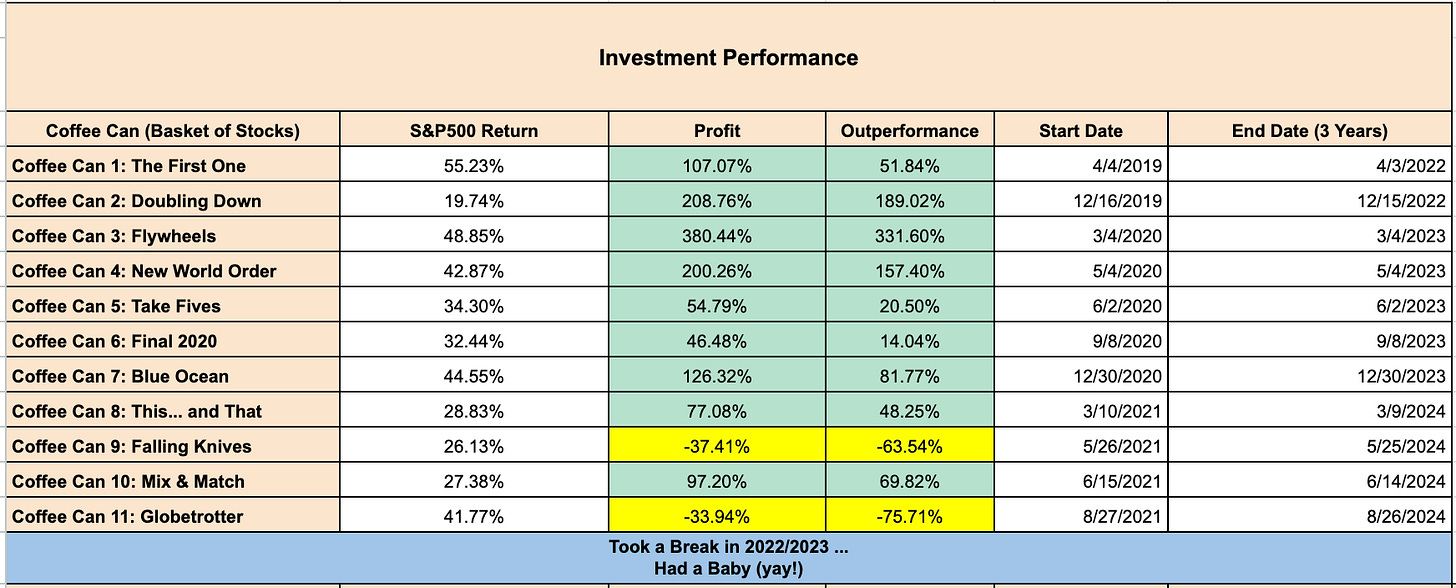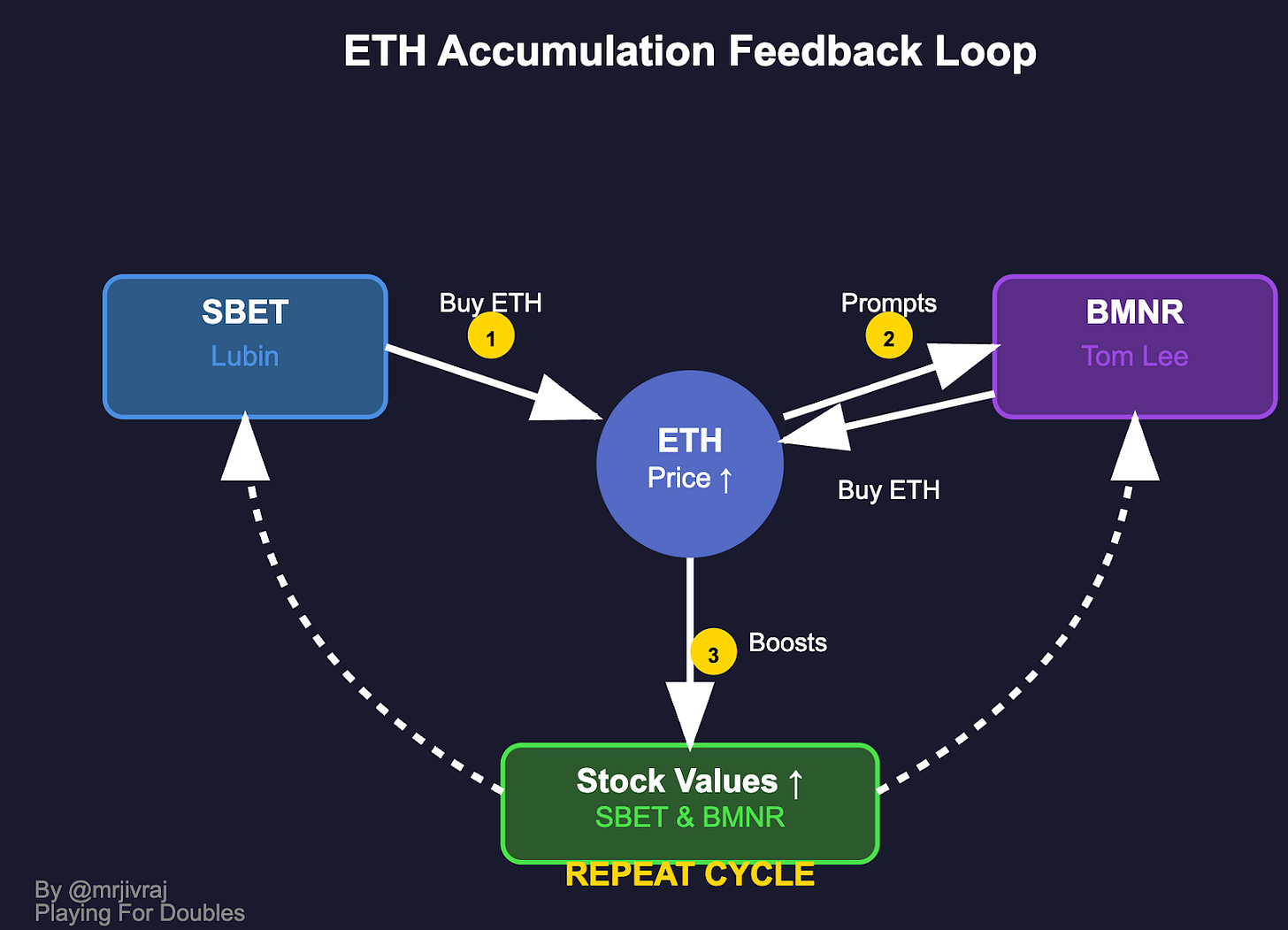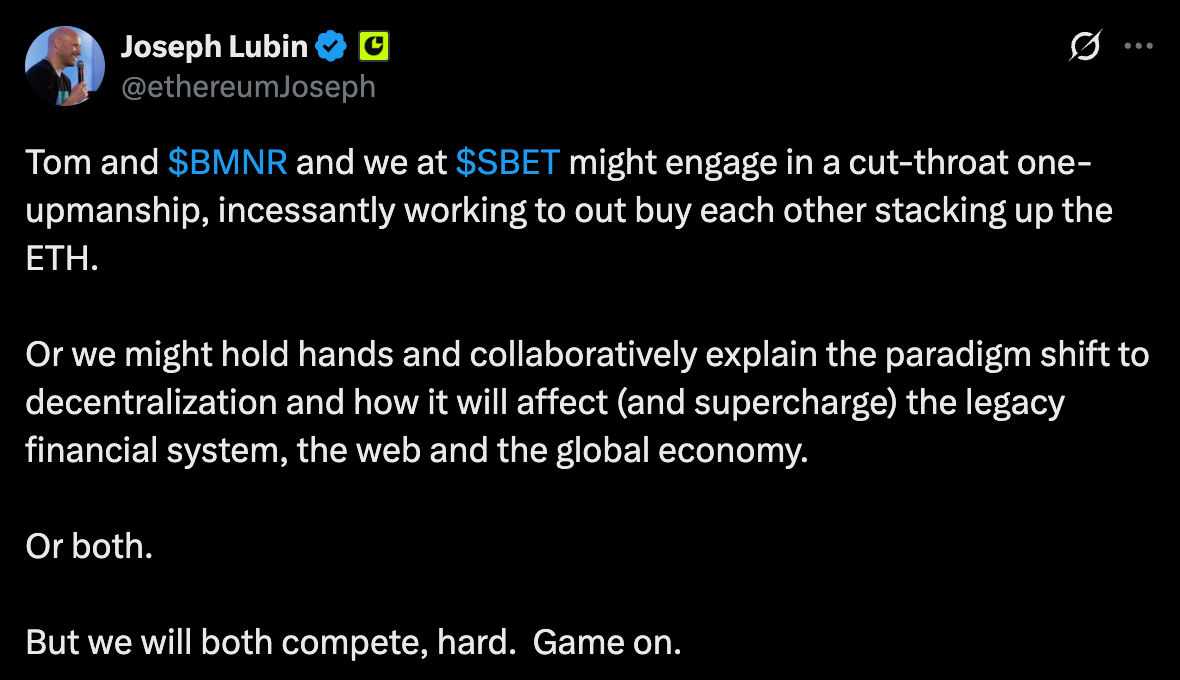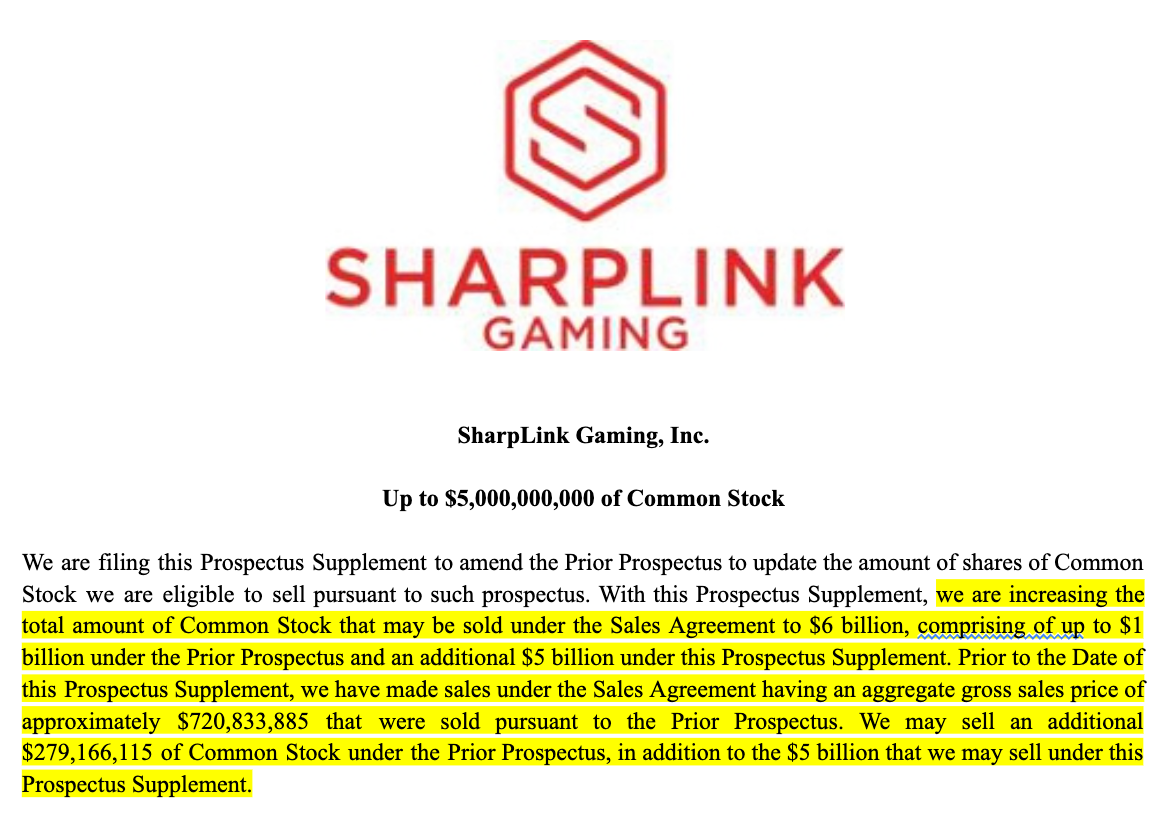If you like this article, please do share it with a friend & click the ❤️ . Thanks :)
If you’re new here, I share “buy-and-hold portfolios” that can double in 3-5 years. The investment philosophy is simple: Try to find the best stocks you can and let them sit for years. Incur no costs with such a portfolio, and it is simple to manage.
Here is our investment performance.
Active Portfolios:
Past Portfolios:
Playing For Doubles Alerts
I’ve been sending free same-day notifications of my buys/sells to folks on the Playing For Doubles Alerts Waitlist. If you’re interested in receiving these alerts, join the waitlist here.
Sharplink Gaming ($SBET) has been the biggest winner of Coffee Can 15 so far. As of this writing, the 7.5% bet was up over 200% in just over a month.
I have been betting on Ethereum for a while, having picked it in Coffee Cans 7, 10, 12, 13, and now once again in Coffee Can 15 (indirectly via SBET).
Why so many times? Well…because winners keep winning. Once we identify a secular winner, we must find a way to buy it, even at higher prices, as it is likely it will keep on winning, and that’s what Ethereum has done. Ethereum in my opinion is now a Stage 3 Maverick, a Leader.
Ethereum is finally going mainstream. The race to dominate Ethereum (ETH) accumulation among public companies has ignited.
Sharplink Gaming ($SBET), led by Ethereum co-founder Joseph Lubin, and Bitmine Immersion Technologies ($BMNR), chaired by Fundstrat’s Tom Lee, have emerged as 2 key players, both positioning themselves as ETH proxies, similar to MicroStrategy’s Bitcoin strategy.
I thought it would be fun to analyze the game theory dynamics between SBET and BMNR. We’ll walk through the game theory framework, considering both companies’ strategies, incentives, and potential outcomes.
First, Game Theory Basics
What is Game Theory? Game theory analyzes strategic interactions between players where the outcome for each participant depends on the actions of others.
Objectives, Strategies and Payoffs
Here, SBET and BMNR are players in a game, each with the following Objectives:
Maximize ETH Holdings: To increase their stake in the Ethereum network.
Enhance Network Influence: By holding significant ETH, they can participate in staking or governance, potentially shaping Ethereum’s ecosystem.
Boost Stock Valuations: As proxies for ETH exposure, they want to attract investors seeking crypto exposure through public equities.
Each player has two primary Strategies:
Aggressive Buying: Raise capital to buy large amounts of ETH, increasing holdings and market attention.
Conservative Accumulation: Gradually acquire ETH using cash flows or smaller offerings, minimizing dilution but potentially falling behind in the race for dominance.
Their Payoffs depend on:
ETH Holdings: More ETH increases network influence and perceived value as an ETH proxy.
Stock Price: Rapid ETH accumulation can drive speculative stock surges (of course, over-dilution and market corrections can scare away investors).
Network Influence: Holding significant ETH allows staking or participation in DeFi, potentially yielding returns or governance power.
Market Perception: Association with high-profile figures (Lubin, Lee) and institutional backing (eg: Founders Fund for BMNR) enhances credibility.
Game Theory Model
Let’s model this as a simultaneous-move game where SBET and BMNR choose between Aggressive Buying or Conservative Accumulation.
The payoff reflects their ETH holdings, stock price impact, and network influence.
For simplicity, we’ll use qualitative outcomes (High, Medium, Low) based on market dynamics.
The Payoff Matrix
Explanation of Payoffs:
Both Aggressive (Medium, Medium):
Both raise significant capital and buy ETH, increasing holdings
This drives ETH prices higher, benefiting both, but risks oversupply of shares (dilution)
Network influence grows, but competition limits dominance.
SBET Aggressive, BMNR Conservative (High, Low):
SBET buys heavily, gaining more ETH and market attention
BMNR lags, with smaller holdings and less stock momentum.
SBET gains more network influence, but BMNR’s conservative approach avoids dilution risks.
SBET Conservative, BMNR Aggressive (Low, High):
BMNR’s aggressive buying outpaces SBET, capturing more ETH and investor interest.
SBET’s slower accumulation limits its influence and stock gains.
Both Conservative (Medium-Low, Medium-Low):
Both accumulate ETH gradually, minimizing dilution.
ETH holdings grow modestly, and network influence remains limited.
This resembles a cooperative outcome but lacks the competitive edge.
This also leaves the door open for a new entrant to enter the game and leapfrog both SBET and BMNR
Nash Equilibrium
A Nash equilibrium happens when neither player can improve their payoff by unilaterally changing their strategy.
Here, the nash equilibrium is (Aggressive, Aggressive):
If SBET plays Aggressive, BMNR’s best response is Aggressive to avoid being outpaced.
If BMNR plays Aggressive, SBET’s best response is Aggressive for the same reason.
The (Medium, Medium) payoff reflects a competitive race where both accumulate ETH rapidly, driving up ETH prices and stock valuations, but risking volatility.
Dominant Strategy
A dominant strategy is a course of action that yields the best outcome for a player, regardless of what strategy the other player(s) choose.
It is the optimal move for a player because it guarantees the highest payoff/best result, in any given situation in the game.
Both players have a dominant strategy of Aggressive Buying because it yields High or Medium payoffs, meanwhile the alternative only yields Low or Medium-Low.
The ETH Accumulation Feedback Loop
This suggests a feedback loop and explains what we have been witnessing in the market:
Lubin’s ETH buying boosts SBET ⇒ This prompts Tom Lee to buy more for BMNR ⇒ This further increases ETH prices and stock values ⇒ That in turn prompts Lubin to buy more ETH ⇒ And so on.
A Coordination Game
The game we have been analyzing is “non-cooperative”, because each company wants to be the leader.
However, since we are so early in this game, we’re more likely in a “coordination” phase right now, where both companies benefit (i.e. maximize payoffs) from rising ETH prices.
Institutional backing (eg: Founders Fund, Pantera for BMNR) and high-profile leadership (Lubin, Lee) amplify market confidence.
Regulatory tailwinds, like the GENIUS Act for stablecoins, also boost Ethereum’s appeal.
In essence, both companies are reaping the rewards of cooperation (eg: pooled resources, amplified influence, and enhanced market credibility for decentralization), while sidestepping the typical challenges of formal partnership, such as vision alignment and shareholder management.
A win-win.
In fact, Lubin just confirmed this:
Stablecoins: A Schelling Point
In game theory, a Schelling point is a solution that people tend to choose in the absence of communication because it is natural or special. It's something players will naturally gravitate towards when trying to coordinate on a strategy, without explicit communication.
Imagine two competing airlines operating routes with similar costs and demand. They each want to maximize profits but are aware that their pricing decisions will affect the other's choices and vice-versa.
Suppose the going rate for a particular route fluctuates between $400 and $600 based on demand and seasonality. Instead of engaging in a price war, which would ultimately hurt both their bottom lines, they might intuitively converge on $500, as the "fair" or "expected" price for that route. This $500 becomes a Schelling point because it's a round number, potentially a common historical price, or simply a psychologically convenient figure.
For ETH Treasury companies, Ethereum’s role in stablecoins may just be the Schelling point for coordination. Tom Lee has proclaimed it to be the “ChatGPT of crypto”. As a result, treasury companies are trying to reinforce Ethereum’s network value, benefiting the ecosystem and also both companies’ share prices.
Numerical Payoffs
BMNR has said that they want to ultimately corner 5% of total ETH supply.
That’s ~6 million ETH.
That’s an order of magnitude more ETH than either SBET or BMNR currently own!
That presents a massive runway ahead.
But this would require some serious shareholder dilution (6 million ETH at $3500 per ETH = $21 Billion, meanwhile these companies currently have a market cap in the single digit billions only).
That's a scary proposition.
The good news however is Microstrategy is a precedent. They have experienced similar dilution over the past several years: As of Dec 2024, Microstrategy share count increased from 15.64 million in August 2020 to 280.828 million (fully diluted), an 18x increase.
That’s a ~95% dilution, but the stock went up ~2,220%+ during that time!
Microstrategy has demonstrated that as long as the dilution is accretive (i.e. BTC per share goes up) and simultaneously, if BTC continues to appreciate, that combination can more than offset dilution.
What does that mean? Like Microstrategy, ETH treasury companies are a leveraged bet on ETH.
So if you believe ETH is undervalued, then owning an ETH treasury company frantically trying to buy up all the ETH they can, despite diluting shareholders, could turn out to be a great bet.
For instance,
SharpLink has increased the amount of common stock it can sell by an extra $5 billion
If they buy $5B of ETH, at current prices, thats about 1.43 million ETH, which would bring their total ETH holdings to 1.7 million.
This implies a post purchase market cap of ~$7.6 Billion:
Current Market Cap = ETH held * ETH price * mNav = 280K * 3500 * 2.7 = $2.6B
New Market Cap = $5B + $2.6B = $7.6B
If that happens, what’s the Upside?
A few scenarios:
$7,500 ETH at 2x mNav = +235%
$10,000 ETH at 2x mNav = +346%
$12,000 ETH at 2x mNav = +436%
A Future Prisoner’s Dilemma
Both companies are tempted to buy ETH aggressively, to outpace the other, leading to a Nash equilibrium of (Aggressive, Aggressive).
This maximizes short-term ETH holdings but creates long-term dilution.
When market sentiment becomes so exuberant creating a speculative frenzy, with users predicting even more ETH buying (irrespective of price), driving both stocks even higher, this risks a bubble.
Eventually, this process becomes unsustainable.
At that point there is a real risk of these two companies facing the Prisoner’s Dilemma, leading to a reversal and a crash. After all, ETH treasury companies are a leveraged bet on ETH, and leverage is a double edged sword.
If that happens, what’s the Downside?
A few scenarios:
$2,500 ETH at 1x mNav = -44%
$2,000 ETH at 1x mNav = -55%
$1,500 ETH at 1x mNav = -66%
That’s a pretty significant downside BUT:
At those prices, I believe ETH is undervalued.
The full dilution won't happen all at once at the current SBET share price.
Arriving at this crossroads will take some time.
For those unfamiliar, the Prisoner's Dilemma is a classic game theory scenario that showcases a conflict between individual self-interest and collective benefit. It shows how two people acting in their own best interest can arrive at a less desirable outcome compared to if they had cooperated.
Prisoner’s Dilemma (Typical Example): 2 Suspects Are Arrested For A Crime
If both stay silent, they get a light sentence.
If both confess, they get a moderate sentence.
However, if one confesses and the other stays silent, the confessor goes free while the silent one gets the harshest sentence.
Each prisoner, acting in their own self-interest, is incentivized to confess, even though mutual silence would lead to a better outcome for both.
In Conclusion
The game theory between SBET and BMNR is a non-cooperative race to amass ETH, driven by the dominant strategy of Aggressive Buying.
The Nash equilibrium is both pursuing aggressive ETH accumulation.
This explains the ETH accumulation feedback loop we have been witnessing.
That said, at this stage of the game, we’re in a “coordination” phase, where Ethereum’s role in stablecoins may just be the Schelling point for coordination.
I expect the race for buying up as much ETH as possible to only heat up from here.
That said, as that race continues, we must be weary of the Prisoner’s Dilemma these ETH treasury companies will eventually face.
If you liked this article, please do share it with a friend & click the ❤️ . Thanks :)
Articles Referenced:












